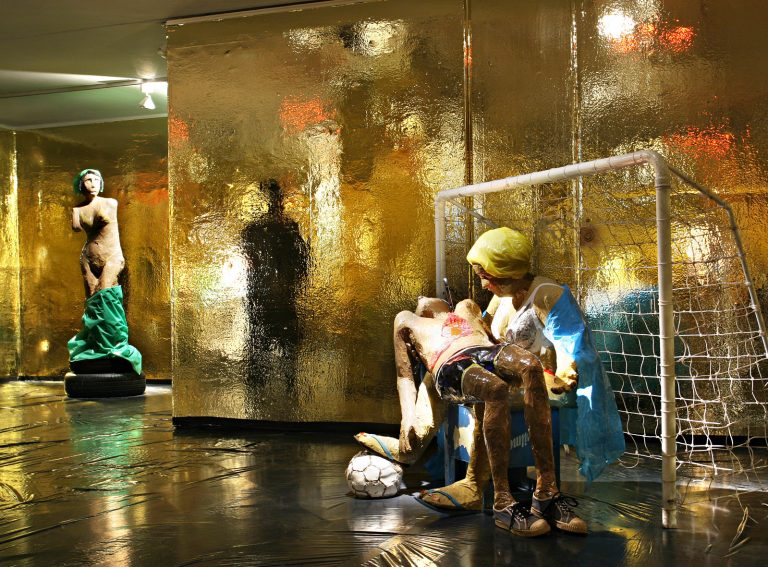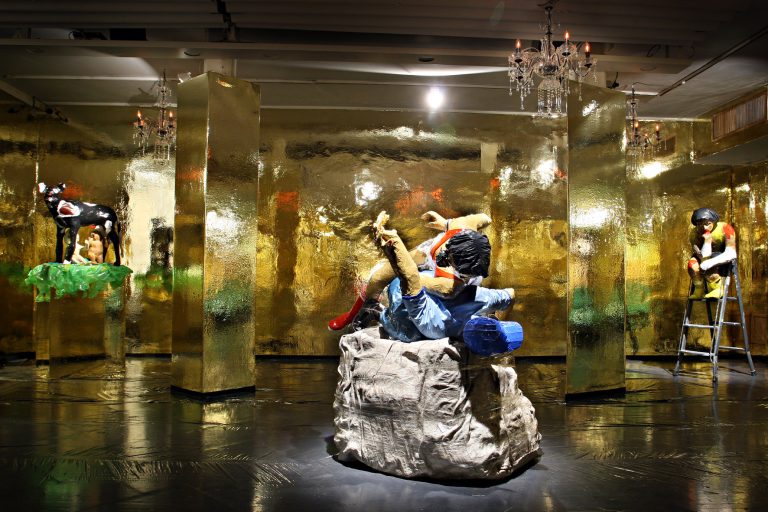Esta noche no
DIEGO FIGUEROA
CENTRO CULTURAL DE ESPAÑA
BUENOS AIRES, ARGENTINA
JUL 7. — SET 4. 2009
EXHIBITION VIEW
works
Tres gracias, 2009
Diego Figueroa
Nylon bags, plastic bags, paper, adhesive tape, rubber and wood
66.9 x 27.5 x 19.6 in
La piedad, 2009
Diego Figueroa
Plastic bags, plastic, paper, adhesive tape, beer boxes, knife, sneakers, leather ball, metal goal and plastic rope
66.9 x 47.2 x 51.1 in
TEXT
ESTA NOCHE NO
Not tonight is the result of a joint project by Diego Figueroa and Edgardo Giménez. It is the coming together of two universes in a single work, as well as a space of encounter, an experience of dialogue.
Edgardo lives his life between the city of Buenos Aires and Punta Indio, a small town 150 kilometers to the south. For him, anything can be a source of artistic inspiration because, through his vision, reality is transformed. If he doesn’t like
what he sees, he changes it to make it more livable, more enjoyable. Edgardo quotes Mae West, the famous Hollywood star, who said “In my long and colorful career, one thing stands out: I have been misunderstood.” Understanding his work is just a question of being willing to have a good time because he reminds us of the beauty of things. His work is partly about not staying within the confines, not accepting limitations; he envisions the world just as he would like it and insists on the feasibility of making it that way. Not accenting the negative is a whole undertaking, a learning process.
Diego shares Edgardo’s passion for work and creation. He embarks on his projects without holding back energies, without skimping on courage or ideas. He uses humor to sustain a critical vision. In his sculptures, he re-creates everyday—if sometimes extreme—scenes on the outskirts of Resistencia, Chaco, the city where he lives. He dares to play with the most classical references from art history, revisiting sculptures like Pietá, Venus of Milo, and The Thinker, stealing their postures and putting them in the skin of characters that, with the utmost care and sophistication, he makes from discarded
materials, wire, and packing tape. Taken from the most marginal and defenseless sectors of the city, his characters are uplifted by a procedure that places them at the center of beauty.
Perhaps what most connects Edgardo and Diego is an attitude before what they perceive, a way of acting on it, a way of creating and embracing risks as par for the course. Fear and speculation have, in their view, nothing to do with art. Things static and safe do not amuse them, which is why neither hesitated to agree to work on a project together even though they did not know one another personally.
The idea that emerged late last year consisted of inviting Edgardo to build a set for a work by Diego. The work began with Diego defining each of the characters. Edgardo then worked on their setting. Surprisingly (or not), he proposed, with not an iota of condescension, a golden space with crystal chandeliers. Furthering Diego’s playful idea of generating a contrast
between the characters and the theme, Edgardo came up with the most unlikely scenario, one that seems incoherent but that, by means of that very tension, puts forth a powerful message: Why not them? Why not tonight?
Later on, the idea of including a soundtrack in the installation emerged. The guest musician, Esteban Peón, was initially asked to compose a work that would bring together classical music and cumbia, though later other genres were added. This procedure based on working with unfamiliar materials, of combining and redefining them, is the concept of authorship
that runs through this work.
Esta noche no is based on the encounters between two artists, between generations, between unknown elements, between distant geographies and identities. An exaggerated space of glimmering luxury exists alongside Diego’s
dramatic characters, images in a strange collage, melodies of universes disjointed that can, nonetheless, coexist in a kind of celebration. And, without even imagining it, we witness a surprising show as both worlds, though antagonistic, converge in a whole that attests to collaboration understood as willingness to interact with the other’s ideas and to allow those ideas to merge with one’s own.
The place of encounter is, in the end, a commitment to celebrating reality in all its elements, contradictions, nuances, dissonances, contrasts, without attempting to reduce its richness, without taking shelter in the value judgments dictated by commonsense, in order to stage a world that, though dreamlike, is no less real.
Laura Spivak
artists
Diego figueroa






